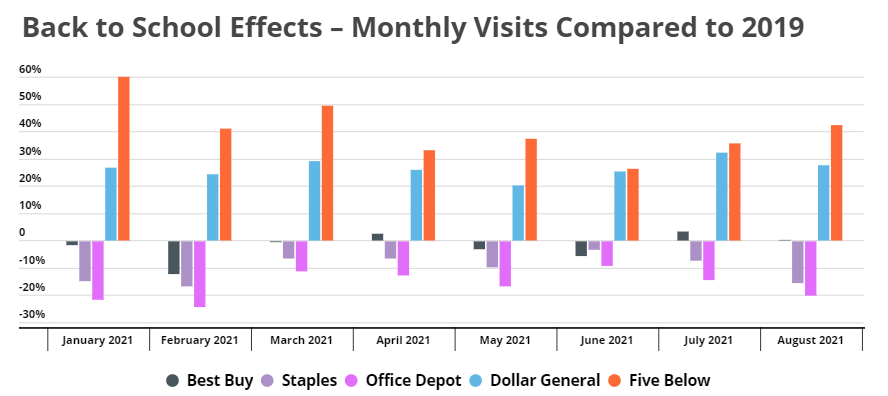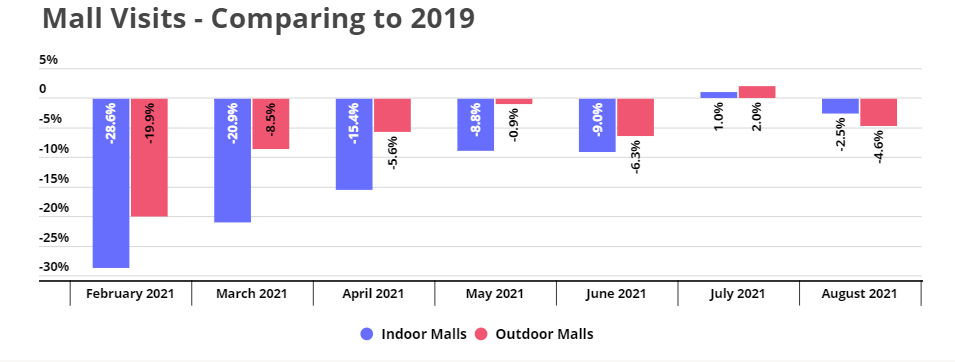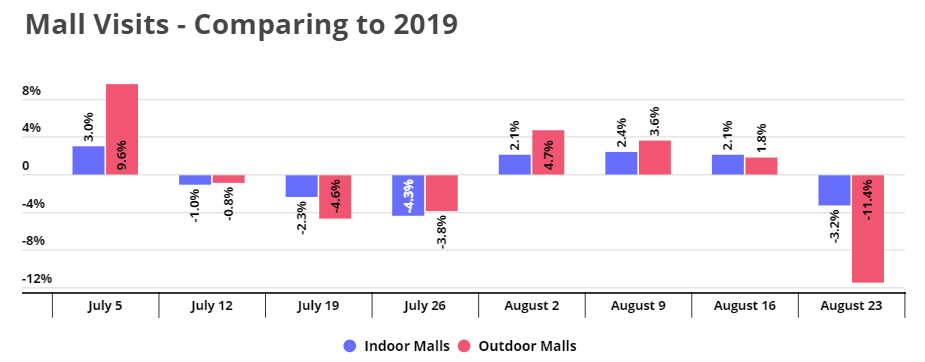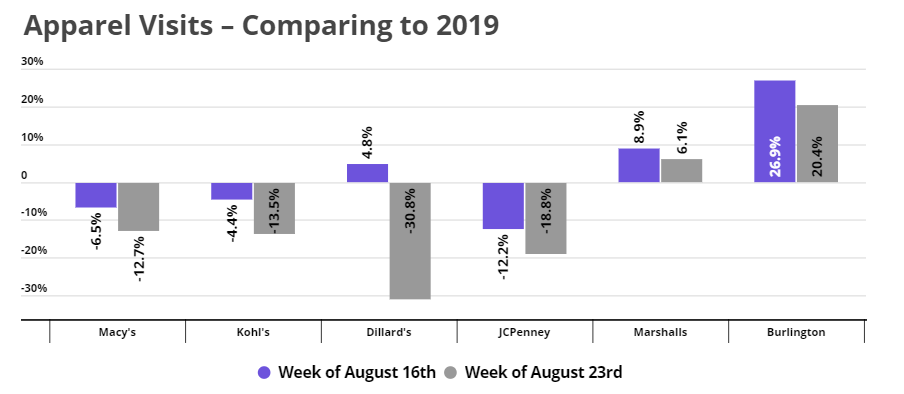
The summer brought positive signs for retail brands across the country with the big box giants, malls and even department stores seeing a needed boost. But with August in the rearview mirror, how much did the summer really contribute to the retail recovery?
Clear Signs of Impact
July and August brought a clear shift in consumer foot traffic, pushing many retail leaders back to positions of growth. Walmart saw visits up 2.9% and 3.9% in July and August when compared to the same months in 2019 – an especially impressive achievement considering the heights hit during that season. The rise in visits is especially significant for Walmart, who while remaining strong throughout the pandemic, also still saw its visits drop as mission-driven shopping and online strength offset more regular visits. Now, the shift to visit growth indicates the likely return of a more traditional balance of shopping patterns.
Target also continued on its 2021 surge with visits up 15.7% in both July and August, sustaining a trend of huge visit increases when compared to 2019. And, like Walmart, Target saw this growth after an extended period where alternative channels and mission-driven shopping boosted revenue even when visits had been down. The increased strength in summer months, even when compared to a strong 2019 period, shows the impact of returning shopping behaviors – especially when aligned with a key retail season like Back to School.

Back to School Effects
And Walmart and Target were not the only retailers who benefited. Best Buy, Dollar General and Five Below were among the retailers who continued to thrive during the Back-to-School period. Dollar stores in particular continued their massive growth numbers, giving further credence to their decisions to expand their respective offline footprints.
But not all brands prospered this summer. While office supply chains like Staples and Office Depot did see their normal seasonal peak, they fell short of the standards set in 2019. Visits for Staples and Office Depot were down 15.3% and 19.9%, respectively, indicating that these brands have been less successful in adapting to the unique work from home opportunity.

A Setback for Malls?
There were also concerns that the rise in COVID cases could impact visits – and the Placer Mall Index showed that may have already been at play by August. After seeing a consistent visit improvement – with visits up in July for both indoor and outdoor malls – visits for both categories returned to declines in August. Indoor malls saw visits down -2.5% compared to August 2019, while outdoor malls were down an even more significant -4.6%.

Yet, it appears that this decline is both misleading and potentially far less significant than it appears at first glance. While visits for both indexes were down in August, much of that decline centered around the week beginning August 23rd when visits were down -3.2% for indoor malls and -11.4% for outdoor malls – the only week of declines for either index.
While COVID cases may have played a role, it is far more likely that the true cause for the decline is the specific week visits were being compared to. The week of August 23rd is being compared to the week beginning August 26th in 2019 – a week that also included the bulk of Labor Day weekend. In 2021, that weekend came in early September. In addition, if COVID concerns were in fact the prime cause, the likely impact would have been far greater on indoor malls as opposed to outdoor – the opposite of what was actually seen.

Even more, the dip between the weeks of August 16th and August 23rd when compared to 2019 were seen across the board with off-price retailers and department store chains also feeling the strain of the more difficult comparison.

An Even Brighter Outlook?
The key takeaway here is that the wider retail sector may actually be in better shape than we initially thought. Visits to retailers – almost across the board – consistently improved throughout the summer, benefitting from the combination of pent-up demand and a key retail period. Yet, the final monthly result was limited by the ‘shift’ of Labor Day deeper into September. With that context in mind, the strength shown by brands like Target, Walmart and Best Buy shines through even more, while concerns of a ‘setback’ for malls and others may be more about calendars than any true weakness. If so, the Back-to-School season could provide a very strong indicator of the potential the 2021 holiday season has to truly return retail to its pre-pandemic status – and an early September boost for malls and their retail tenants.
To learn more about the data behind this article and what Placer has to offer, visit https://www.placer.ai/.







Sign up to receive our stories in your inbox.
Data is changing the speed of business. Investors, Corporations, and Governments are buying new, differentiated data to gain visibility make better decisions. Don't fall behind. Let us help.













Sign up to receive our stories in your inbox.
Data is changing the speed of business. Investors, Corporations, and Governments are buying new, differentiated data to gain visibility make better decisions. Don't fall behind. Let us help.





